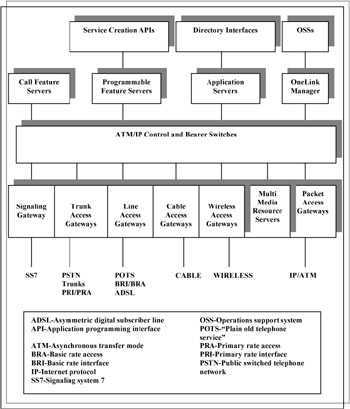Rationale
|
| < Day Day Up > |
|
Traditionally, the major telecommunication companies have provided two independent services to their network users: packet-based data and circuit-based voice telephony. Interdependence of these services has caused bottlenecks, redundancies, and chaos in the networks. The CM eliminates these network problems by converging the two services together as a unified entity of the packet networks. To reduce problems, CM helps the network providers with third-party programmability and support. Service convergence also includes the transmitting of voice and data through the network's systems. In addition, the model standardizes the network's applications, which eliminates dependency and reliance on one vendor. However, integration of the network services decreases its complexity and operability costs and increases service consolidation and functionality (Parker, 2000; Van Vliet, 2000).
Originally, packet switching was developed for computer telecommunications networks. The model employs switching technologies to converge other network systems such as transmitting, transporting and accessing along with their products and services. It employs object-oriented programming, distributes client and server simulation modeling, middleware processing, and open application programming interfaces to standardize the model's application and usage (Eldering & Sylla, 1999; Keenly, 2001; Morrison, 2000).
The CM architecture has made it feasible for complex networks to provide data communications through various media transports: wired and wireless access; narrow and broadband; and Internet-based technologies. These new technologies are the foundations of the CM voice and data communication convergence that can be used in modern Internet-based networks (Chatzipapadopoulos et al., 2000; Dixit & Guo, 2001).
Modern, mechanized TI networks are urgently in need of convergence of voice and data, as well as computer and Internet communications. The CM packet-switching technologies are able to converge broadband voice, data, and video access. The CM technologies are also capable of supporting wireless technologies such as asymmetric digital subscriber line (ADSL), wideband code division multiple access (W-CDMA), and wideband time division multiple access (W-TDMA). Without any complications, these different technologies are bridged into the CM, providing a common packet node with a core set of services across all the access types (Solomon, 1998; Wade & Lewis, 1999). The CM technology is able to efficiently service between the end points of different types without interference from each type. The CM packet-switch technology provides TI users with real-time web-based, customized service interfaces such as application programming interface (API). Using object-oriented-based and programmable feature services (PFS) technologies in a distributed processing environment (DPE), CM standardizes the web-based user platform services (Jerome & DeLeon, 2000; Parker, 2000). Figure 2 shows the CM packet-switching solution architecture and its components.

Figure 2: Model's packet-switching solution architecture and its components
|
| < Day Day Up > |
|
EAN: 2147483647
Pages: 174